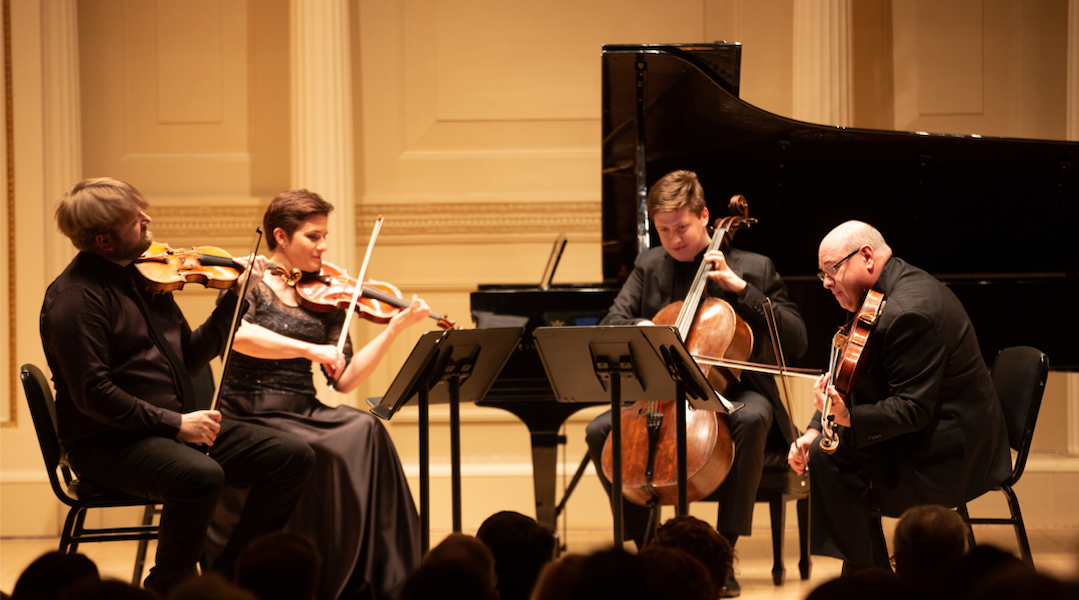University of Indianapolis presents The Indianapolis Quartet in Review
Zachary DePue, violin; Joana Genova, violin; Michael Isaac Strauss, viola; Austin Huntington, cello
Drew Petersen, piano
Weill Recital Hall at Carnegie Hall, New York, NY
March 5, 2020
The Indianapolis Quartet made an exciting, auspicious New York debut on Thursday night. It is young, as quartets go, formed only in 2016, but it has quickly rocketed to the forefront of well-deserved attention. The quartet plays standard repertoire, judiciously combined with contemporary American works, which are often written expressly for it. The ensemble’s strength is in its energetic, often kinetic, enthusiasm, and each player’s individual virtuosity and flexibility—ideal conditions for a unified group. The interpersonal communication was a joy to behold, with plenty of ease which allowed for smiling and eye contact. On this occasion the quartet played two iconic nineteenth century works (one with piano), and two contemporary works (one a world premiere).
The evening began with Frank Felice’s humorous Five Whimsies for Non-Grown-Ups, brief programmatic movements based on children’s books the composer re-acquired in adulthood (Sendak, Tolkien, Seuss, etc.). The quartet’s playing was so clear and their ensemble so perfect that I could almost “read the score” in my head, although the composer and his work were previously unknown to me. The most successful movement, for me, was “Great yawns are in blossom,” which nearly rose to Barber Adagio grandeur. The composer, in attendance, gratefully received his due applause, and showed his beaming approval of the ensemble, any composer’s dream.
The quartet followed this with a thrilling rendition of the great Schumann Piano Quintet in E-flat major, Op. 44, the first great work for this combination in the nineteenth century, acclaimed and beloved immediately after its premiere, by all except perhaps the work’s instigator: Franz Liszt, who called it “Leipzig” music. Maybe he was referring to the omnipresent squareness of phrasing. It takes a great deal of refinement to make the listener forget about that issue, and we were in good hands here, with the addition of pianist Drew Petersen (an Avery Fisher Career Grant recipient!) to the excellent quartet. This rendition thrived on the electric energy of all the players. There was only one “miscalculation” in my opinion: the second movement’s principal theme, a funeral march, should have a more searching, broken quality, more mystery; it’s very difficult to achieve, and they were in fact playing the movement in the proper tempo. The ensemble eventually got to that quality in the final page of the movement. Naturally, the quick movements were played with excitement that did not exclude sensitivity. Not only is the work cyclic, but the descending six-note “Clara” cipher appears in the first two movements, secret messages being Schumann’s default setting.
After intermission came the world premiere of Robert Paterson’s Quartet No. 3, which is also a five-movement series of programmatic content. This is high-energy music, perfectly suited to the quartet’s strengths. The Auction Chant movement was a wild romp, a description of the frenetic sing-song of a typical auctioneer, combined with witty references to country fiddling, often found in conjunction with such sales. Anthem was a humorous take on fight songs and state songs played at sporting events. The other three movements were harder to define—if one hadn’t read the program notes, perhaps they could have been about “anything,” which is a recalcitrant issue with program music ever since its beginnings. Nevertheless, they provided a great vehicle to display the Indianapolis’ many virtues. Paterson, also in attendance, took his bow to the roar of the appreciative audience.
The group closed with Debussy’s iconic String Quartet in G minor, “Opus 10,” which is funny because it is the only work with an opus number in Debussy’s output, added by his reluctant publisher to make it seem more “official.” This is a monothematic, four-movement work, with constantly shifting, elusive harmonic subtleties, modal inclinations, and the groundbreaking “tritone dominant,” in this case G-C sharp (sometimes spelled D-flat), which occurs not only melodically, but in the tonal relationships of the movements. Here the Indianapolis Quartet showed its most ravishing playing of the night. They fully revealed the inherent beauty and mystery in the score, creating ethereal dynamic contrasts, while faithfully executing everything this elaborate work demands. It was a dazzling achievement.

